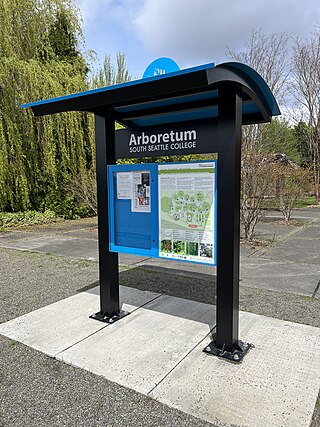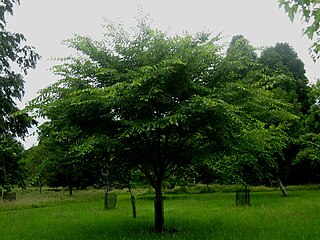
An arboretum is a botanical collection composed exclusively of trees of a variety of species. Originally mostly created as a section in a larger garden or park for specimens of mostly non-local species, many modern arboreta are in botanical gardens as living collections of woody plants and is intended at least in part for scientific study.

Highstead, formerly known as Highstead Arboretum, in Redding, Connecticut, United States was founded in 1982. It covers 36 acres of woodland, meadow, and wetland and ranges from 640 feet (200 m) to 758 feet (231 m) in elevation and hosts both native and cultivated plant varieties.

Red Butte Garden and Arboretum consists of a botanical garden, arboretum, and amphitheatre operated by the University of Utah, in the foothills of the Wasatch Range in Salt Lake City, Utah, United States. It is open year-round to the public. Red Butte Garden contains over 100 acres (0.40 km2) of botanical gardens and several miles of hiking trails through native vegetation. Red Butte Creek runs within the northern part of the garden.

The University of California, Irvine Arboretum is a 12.5 acres (5.1 ha) botanical garden and arboretum, part of the University of California, Irvine in Irvine, California. It is located north of the main UCI campus, on Campus Drive in Irvine, near the San Joaquin Wildlife Sanctuary and the Upper Newport Bay. The Arboretum carries out conservation activities and supports student and faculty research.

The Harold L. Lyon Arboretum is a 200-acre (0.8 km2) arboretum and botanical garden managed by the University of Hawaiʻi at Mānoa located at the upper end of Mānoa Valley in Hawaiʻi.
The Brenton Arboretum is a 141-acre arboretum and public garden in Dallas Center, Iowa, United States, established in 1997. The arboretum displays 175 native Iowa trees and shrubs suitable to the site, as well as many other tree species which can grow in central Iowa. The non-profit arboretum is open to the public from 9 am to sunset on Tuesday through Sunday, featuring a collection of over 2,600 trees and shrubs on display.

The Stanford University Arboretum is an arboretum located on the grounds of Stanford University in Stanford, California. It is open to the public daily without charge.

Secrest Arboretum is an arboretum located on the campus of the Ohio Agricultural Research and Development Center (OARDC), at the intersection of Pine Road and Green Drive, Wooster, Ohio. It is open daily without charge and hosts an estimated 10,000 visitors each year.

Chadwick Arboretum is a 62 acres (25 ha) arboretum on the Agriculture campus of The Ohio State University, in Columbus, Ohio, United States. The main arboretum collection is located just across Lane Avenue from the Schottenstein Center with its other collections nearby. The arboretum is open daily without charge.

The South Seattle College Arboretum is a 6-acre (24,000 m2) arboretum and botanical garden located at the north end of the South Seattle College campus in Seattle, Washington. It is open daily without charge. The Seattle Chinese Garden is adjacent.

The Arboretum Kalmthout is a botanical garden in Kalmthout, Belgium. It was started as a tree plantation by Charles Van Geert in 1856. Van Geert developed a collection of rare plants and trees before selling the property after 40 years to Antoine Kort. Kort added an extensive collection of Hamamelis or witch hazel to the nursery, but was forced to close his business due to the Great Depression of the 1930s. In 1952, the property was purchased by the brothers Georges and Robert de Belder, to save it from being destroyed by a housing development. At the site, the year that they purchased the property, the de Belder brothers founded the International Dendrology Society (IDS) to promote preservation and conservation of rare or endangered woody plants. Robert de Belder and his wife, Jelena de Belder-Kovačič worked together to build an internationally known arboretum, where plant enthusiasts could study and exchange knowledge and information about plants. In 1986 it became property of the Antwerp province and is now open to public.

Ulmus davidiana, also known as the David elm, or Father David elm, is a small deciduous tree widely distributed across China, Mongolia, Korea, Siberia, and Japan, where it is found in wetlands along streams at elevations of 2000–2300 m (6,500–7,500 ft). The tree was first described in 1873 from the hills north of Beijing, China.
Mast Arboretum is a 10-acre (4.0 ha) arboretum and botanical garden on the campus of Stephen F. Austin State University in Nacogdoches, Texas, one of 4 main gardens on the campus. The arboretum is open daily without charge.

Ulmus 'Exoniensis', the Exeter elm, was discovered near Exeter, England, in 1826, and propagated by the Ford & Please nursery in that city. Traditionally believed to be a cultivar of the Wych Elm U. glabra, its fastigiate shape when young, upward-curving tracery, small samarae and leaves, late leaf-flush and late leaf-fall, taken with its south-west England provenance, suggest a link with the Cornish Elm, which shares these characteristics.

The Forstbotanischer Garten und Pflanzengeographisches Arboretum der Universität Göttingen, often called the Forstbotanischer Garten und Arboretum, is a 40 hectares arboretum and botanical garden maintained by the University of Göttingen. It is located at Büsgenweg 2, Göttingen, Lower Saxony, Germany, immediately adjacent to the New Botanical Garden, and open to the public daily.

The Old Botanical Garden of Göttingen University, with an area of 4.5 hectares, is an historic botanical garden maintained by the University of Göttingen. It is located in the Altstadt at Untere Karspüle 1, adjacent to the city wall, Göttingen, Lower Saxony, Germany, and open daily.

The Botanische Garten der Martin-Luther-Universität Halle-Wittenberg is an arboretum and botanical garden maintained by the University of Halle-Wittenberg. It is located at Am Kirchtor 3 in the city of Halle, Saxony-Anhalt, Germany, and open daily in the warmer months. An admission fee is charged.
The Neuer Botanischer Garten der Universität Göttingen, also known as the Experimenteller Botanischer Garten, is a research botanical garden maintained by the University of Göttingen. It is located immediately adjacent to the university's Forstbotanischer Garten und Arboretum at Grisebachstraße 1, Göttingen, Lower Saxony, Germany, and open daily without charge.

The Ulmus pumila cultivar 'Aurescens' was introduced by Georg Dieck at the National Arboretum, Zöschen, Germany, circa 1885. Dieck grew the tree from seed collected in the Ili valley, Turkestan by the lawyer and amateur naturalist Vladislav E. Niedzwiecki while in exile there. Dieck originally named the tree U. pinnato-ramosaf.aurescens.
















